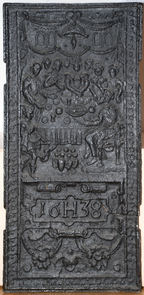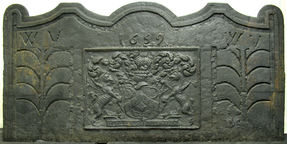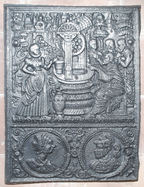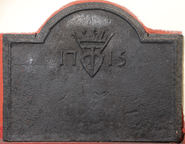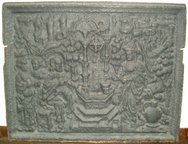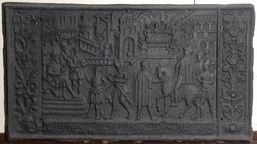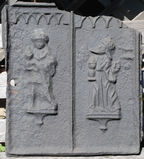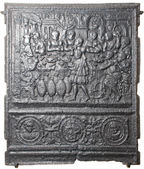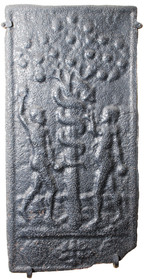-
60
Description: Fragment; rectangular; flanged top edge; probable symmetrical arrangement of crowned Tudor royal shield stamps (4 above 3); vertical line on either side of each shield; left hand print in bottom left corner, probably mirrored on right.
Notes: The right side of the fireback is missing. Very crude modelling of stamp suggests an early date; the same crowned shield and use of hand print can be seen on a fireback at Rolvenden (no. 661), indicating a common source..
- Decoration tags:
- rectangular (shape)
- flanged (edging)
- simple stamps
- carved stamps
- heraldic
- humans
Manufactured: in the early- to mid-16th century in the Weald area of England.
Current location: in private hands, Etchingham, East Sussex, England.
- Attached to series:
- Hand print firebacks
- Early Tudor series
- Tudor royal armorial firebacks
-
565
Description: Rectangular; flanged edging; small guilloche pattern down each side and along the bottom; upper panel, pictorial scene of the Marriage at Cana; lower panel, inscription panel within a strapwork cartouche with flowers below.
Notes: An end stove plate with a popular scene from the New Testament - John 2.
Copies of this fireback are known.
Inscription: 16 H 38
- Decoration tags:
- rectangular (shape)
- flanged (edging)
- whole carved pattern
- pictorial
- biblical
- text
- humans
Manufactured: in 1638 possibly in the Siegerland area of Germany.
Current location: Folkestone Library and Heritage Centre, Grace Street, Folkestone, Kent, England.
(part of the Folkestone Library and Heritage Centre museum group)
- Attached to series:
- Stoveplates
- Marriage at Cana stoveplates
-
108
Description: Quasi-rectangular with narrow arches at top ends and a broad low central arch, between which are flat-topped peaks linked to the arches by shallow concave curves; flanged edge (top and sides); mirroring the edge a channel has been engraved into the metal, extending into the small arches, producing the effect of a wide fillet along the top and sides with an inverted U-shaped return into the end arches; within the channel, at each end, a primitive representation of a vertical, hollow plant stem and four mirrored pairs of curved branches, with a vertical channel parallel to the edge joining the branch ends on the inside; between these is cast a small, rectangular panel with ovolo edging, bearing a full achievement of the arms of the Worshipful Company of Clothworkers; the date is centrally placed above this panel.
Notes: An usual fireback for several reasons: the use of engraving for significant elements of the design, the flanged edge, and the incorporation of a small fireback. The Clothworkers’ arms: Sable a chevron ermine between in chief two Havettes Argent and in base a Teazel Cob Or; crest: on a Mount vert a Ram statant Or; supporters: two Griffins Or pellettée; the arms as displayed were granted in 1587. An example of the armorial fireback on its own is in Petworth House (no. 522).
Inscription: WV 1659 WV
Arms: Worshipful Company of Clothworkers
- Decoration tags:
- rectangular with three arches (shape)
- flanged (edging)
- composite
- individual numbers
- planklines
- armorial
- text
Manufactured: in 1659 in the Weald area of England.
Current location: Haslemere Educational Museum, Haslemere, Surrey, England.
Museum number: 8587 (part of the Haslemere Educational Museum museum group)
- Attached to series:
- Composite firebacks
- Livery company firebacks
-
357
Description: Stove side plate; ovolo moulded edging; upper panel, pictorial scene of Jesus and the woman of Samaria (John: 4), with inscription below; lower panel, two circular frames, each with a figure, male to the right, female to the left, decorative scroll work between.
Notes: Stove plates were often used as firebacks once the stoves had been replaced by more efficient ones.
Inscription: VON DEN FREWLEIN VON SAMARIA IOHAN 4
- Decoration tags:
- rectangular (shape)
- flanged (edging)
- whole carved pattern
- planklines
- pictorial
- biblical
- architectural
- text
- humans
- objects
Manufactured: in the late-16th to early-17th century in the Eifel area of Germany.
Current location: Baddesley Clinton Hall, Knowle, Warwickshire, England.
(part of the National Trust museum group)
- Attached to series:
- Stoveplates
- Woman of Samaria stoveplates
-
389
Description: Arched rectangular shape; plain edge with inset astragal on all sides; stylised buckle surmounted by an earl’s coronet between the two halves of the date.
Notes: The buckle is the badge of the Pelham family and the earl’s coronet may refer to the Earldom of Clare to which Thomas Pelham-Holles, 2nd Baron Pelham of Laughton was raised in 1714. The following year he was created Marquess of Clare and Duke of Newcastle-upon-Tyne. Formerly part of the J. H. Every collection.
Inscription: 17 15
- Decoration tags:
- rectangular with round arch (shape)
- flanged (edging)
- carved stamps
- individual numbers
- heraldic
- text
Manufactured: in 1715 in the Weald area of England.
Current location: Anne of Cleves House, Southover High Street, Lewes, East Sussex, England.
Museum number: 1944.24.084 (part of the Sussex Archaeological Society museum group)
- Attached to series:
- Pelham family firebacks
-
420
Description: Rectanglular; flanged cavetto-moulded edging; pictorial scene of Christ and the woman of Samaria at Jacob's Well.
Notes: Stoveplate; the scene illustrates the story from John 4.
- Decoration tags:
- rectangular (shape)
- flanged (edging)
- whole carved pattern
- pictorial
- biblical
- humans
Manufactured: in the late-16th to early-17th century possibly in the Eifel area of Germany.
Current location: Anne of Cleves House, Southover High Street, Lewes, East Sussex, England.
Museum number: LH000.797 (part of the Sussex Archaeological Society museum group)
Citation: Dawson, C., 1903, 'Sussex Iron Work and Pottery', Sussex Archaeological Collections, 46, pp. 1-54.
- Attached to series:
- Stoveplates
- Woman of Samaria stoveplates
-
421
Description: Rectangular; flanged edge; central pictorial panel illustrating Mordecai arriving before King Ahasuerus, Haman hanging from the gallows behind; two floral side panels, at the top of each a monogram within a cartouche: on the left KS, on the right H?D.
Notes: Stoveplate; the scene illustrates a scene from Esther 7: 10 and 8: 1. Formerly part of the J. H. Every collection.
Copies of this fireback are known.
Inscription: KS H[?]D
- Decoration tags:
- rectangular (shape)
- flanged (edging)
- whole carved pattern
- pictorial
- biblical
- architectural
- text
- humans
Manufactured: in the late-16th to early-17th century possibly in the Eifel area of Germany.
Current location: Anne of Cleves House, Southover High Street, Lewes, East Sussex, England.
Museum number: 1944.24.040 (part of the Sussex Archaeological Society museum group)
- Attached to series:
- Stoveplates
- Esther stoveplates
-
434
Description: Damaged; rectangle, flanged edging; two vertical panels, each with a row of lancet arches along the top: on right, robed figure with a crown, head tilted to left, left hand raised in benediction, right hand holding a chalice, standing on a bracket; on right, similar figure facing forward.
Notes: Stoveplate. Similar plates suggest these may be two of the Magi.
- Decoration tags:
- rectangular (shape)
- flanged (edging)
- simple stamps
- architectural
- humans
Manufactured: in the early-16th century in the Eifel area of Germany.
Current location: Anne of Cleves House, Southover High Street, Lewes, East Sussex, England.
Museum number: LH000.795 (part of the Sussex Archaeological Society museum group)
Citation: Dawson, C., 1903, 'Sussex Iron Work and Pottery', Sussex Archaeological Collections, 46, pp. 1-54.
- Attached to series:
- Stoveplates
- Figurine firebacks
-
547
Description: Rectangular with flanged edging; upper rectangular panel with cyma recta edging; pictorial scene of the Marriage at Cana; lower rectangular panel with fillet edging; three circular medallions with twin, concentric fillet edges, the left one with the bust of male, the right one with the bust of a female and the centre one with a floral design.
Notes: The scene is from the New Testament - John 2. Mitford collection, Petworth House.
- Decoration tags:
- rectangular (shape)
- flanged (edging)
- whole carved pattern
- planklines
- pictorial
- biblical
- humans
Manufactured: in the late-16th to early-17th century possibly in the Eifel area of Germany.
Current location: Petworth House, Petworth, West Sussex, England.
Museum number: NT/PET/M/103 (part of the National Trust museum group)
- Attached to series:
- Stoveplates
- Marriage at Cana stoveplates
-
562
Description: Rectangular; flanged edging; main panel, pictorial scene of Adam and Eve with, between them, the Tree of Life, bearing fruit, entwined by a serpent; bottom panel indistinct.
Notes: A much worn plate. Mitford collection, Petworth House.
Copies of this fireback are known.
- Decoration tags:
- rectangular (shape)
- flanged (edging)
- whole carved pattern
- pictorial
- biblical
- humans
Manufactured: in the mid- to late-16th century possibly in the Wallonia area of Belgium.
Current location: Petworth House, Petworth, West Sussex, England.
Museum number: NT/PET/M/56 (part of the National Trust museum group)
- Attached to series:
- Stoveplates

